A personalized trustworthy service selection method
Wu Xiaona Li Bixin Li Chao
(School of Computer Science and Engineering, Southeast University, Nanjing 210096, China)
Web service selection methods can generally be divided into two categories:functional-based meth-ods and non-functional-based methods.[1]Non-functionalbased methods mainly focus on how to find the optimal service among the functional equivalent candidate services[2].
Trust as a non-functional attribute should be taken into consideration in service selection because of the open dynamic environment of web services.A large number of trust and reputation approaches have been proposed[3].These approaches assist users to select services by aggregating their own experiences and other past users'recommendations.The weight of each recommendation is determined either by the similarity between users[4]or the recommender's capability[5].But the aggregating algorithms of these methods are complex,and extra cost is required for algorithm design and computation.Moreover,experiences and recommendations are ratings represented as real numbers in the interval[0,1].However, trust is a complex subjective term in fact,and only these one-dimensional ratings cannot fully reflect why a service is trustable or not.
Some other researchers build trust based on a set of quality of service(QoS)attributes[6-10].Due to the versatility of QoS attributes,users evaluate trust of a service according to their requirements and preferences.Weight is assigned to each attribute according to users'specifications[7-8].Although these methods have taken multi-dimensional attributes and users'preferences into consideration, there still exist some problems.On the one hand,weights are assigned by users subjectively,which requests them to have advanced knowledge and experiences.On the other hand,different QoS attributes may have different measurement units and numeric intervals.Some attributes are negative,which means that the higher the value, the lower the quality, while some are positive.Thus,the attributes must be normalized before calculating,and the data processing may cause deviations.
This paper defines trust as a set of metrics according to users'requirements.A personalized service selection method is proposed,in which analytic hierarchy process(AHP)is used for calculating the weight of each trust metric according to users'preferences,and the preference ranking organization method for enrichment evaluations(PROMETHEE)is used for ranking the candidate services.
1 Personalized Trust Metrics
Definition 1Trust metrics are the information of an entity that is required and used to evaluate the trustworthiness of that entity[11].
The term “metric”represents the need to quantify the information and it is defined as a set of measures necessary for evaluating trust.Trust metrics are user-defined and can be expanded by other non-functional attributes according to users'requirements.In this paper, trust met-
rics include duration, price, reliability, availability and user satisfaction,because these are the most commonly used attributes for establishing trust[7].The personalized trust metrics are denoted as

whereQduration(s),Qprice(s),Qrel(s), andQav(s)denote the duration, price, reliability and availability of services, respectively, and the definitions are similar to those defined in Ref.[12].The definition of the user satisfaction is given in the following.
Definition 2User satisfaction is the prediction of the satisfaction after invoking the target service.Qsa(i,s)denotes the user satisfaction of servicesfrom the perspective of useri.
Users can obtain price, duration, reliability, and availability values either from service providers or the past execution history.The calculation of the user satisfaction value is as follows:

A service user's own experience plays an important role in satisfaction calculation.We calculate user satisfaction combining the service requester's own satisfaction from historical interactions and other users'recommendations based on their own satisfaction.After each invoking, a service user provides a rating indicating the level of satisfaction with the service.The rating is simply a real number in the interval[0,1].We consider the number of historical interactions denoted asm.If the number is greater than thresholdM,the satisfaction comes from the user's historical direct interaction experience.If the interaction experience is insufficient,the satisfaction should refer to the recommendations from other users.Qown-sa(i,s)is the rating representing a service user's own experience about satisfaction.The most recent rating replaces the older one.Qrepis the average satisfaction of all users, which is also called reputation,and it is calculated as

whereNis the number of users who have interacted with the target service in the past.
2 Service Ranking and Selection
A method combining AHP[13]and PROMETHEE[14]is proposed for trustworthy service selection,in which AHP is used to calculate the weight of each metric,and PROMETHEE is used to rank the candidate services.The process of service ranking and selection is shown in Fig.1.

Fig.1 The process of service ranking and selection
2.1 Determine weights via AHP
The AHP method is used to determine the weights of trust metrics, and the process is shown in the following.
Step 1Construct the hierarchy
Based on the trust metrics including duration, price,reliability,availability and user satisfaction,the hierarchy is generated as shown in Fig.2.The higher level is determined or measured by lower level attributes.

Fig.2 The AHP hierarchy model of service selection
Step 2Assign weight to each metric
The service user uses a pairwise comparison mechanism to determine the relative priority of each metric.Staaty's 1-9 scale[13]is used for pairwise comparison:1 means the equal importance,9 means the highest level of importance.For instance, if the service requester thinks that price is essentially more important than availability,thena24=5.After the pairwise comparison, matrix A is constructed as

The relative weights for each trust metric are given by the right eigenvector ω corresponding to the highest eigenvalue λmax, and the weights can be obtained by normalizing any of the rows or columns of A.
Step 3Consistency check
Inconsistency means that the pairwise comparisons made by users appear contradictory.For example, it is inconsistent in the case where a service user thinks that reliability is strongly more important than duration,and duration is moderately more important than user satisfaction,and user satisfaction is moderately more important than reliability.The consistency index(CI)is shown as


It indicates whether the evaluations are sufficiently consistent.
The RI is obtained from the random consistency index table[13].If CR≤0.1, the consistency rate is acceptable;otherwise,matrix A needs to be revised to calculate again.Finally,the weight of each trust metric can be obtained.
2.2 Service ranking via PROMETHEE
PROMETHEE[14]is used to rank the candidate services, and the process is shown in the following.
Step 1Define the preference functions and parameters for metrics
PROMETHEE performs pairwise comparisons by considering the deviation between the evaluations of the alternatives.The preference function is denoted as

where for the positive attribute

and for the negative attribute

PROMETHEE has six pre-defined preference fun ctions[14].The preference functions are chosen according to the inherent characteristics of the trust metrics.A small deviation of duration between the evaluations of two alternatives is negligible,so the preference function of duration is V-shaped with an indifference criterion;the preference function of price is a V-shaped criterion because the preference on price is linear;the preference function of reliability,availability and user satisfaction is a Gaussian criterion because the preferences for these attributes are
The final consistency ratio(CR)is calculated as nonlinear.
Step 2Calculate the positive,negative and net outranking flows

where π(s,s1)measures how muchsis preferred overs1on all the trust metrics, and π(s1,s)measures how muchs1is preferred overs.
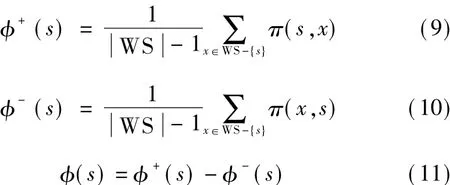
The positive outranking flow, denoted as φ+(s), expresses how an alternativesis dominating the other ones,which means that the higher the value,the better the alternative.The negative outranking flow, denoted as φ-(s),expresses how an alternativesis dominated by the other alternatives,which means that the lower the value, the better the alternative.The net outranking flow,denoted as φ(s), is the balance between the positive and the negative outranking flows,which means that the higher the value, the better the alternative.
Finally,the rank of alternative services can be generated.Then,the user can select the top one candidate to invoke and puts other topN-1 services on standby.
3 Case Study
In order to explain how past experiences of interaction can be used to evaluate user satisfaction,and verify that the proposed personalized service selection method can effectively express users'preferences for the multi-dimensional trust metrics,a case study is presented in this section.
Since there is neither a standard web service test platform,nor standard test data till now,we adopt the method of randomly generating ten functional equivalent candidate web services with five dimensional attributes as shown in Tab.1.The user satisfactions are initial values,so that the satisfactions of all users are the same at the beginning.Before using the PROMETHEE method, for each attribute,a specific preference function and its parameters are defined as provided in Tab.2.
Case 1Changes of user satisfaction and service rank according to the experiences of interactions
We simulate fifty service users and ten functional equivalent services in the Netlogo[15]platform.Every user randomly invokes one of the ten services per clock cycle and gives a direct user satisfaction value based on the experience of interaction.All the users can providerecommendations for the target user,and the final user satisfaction is calculated according to the method proposed in section 2.To illustrate that user satisfaction values change with interaction times,we randomly select one of the fifty users and observe the changes of his user satisfaction towards the target service.Fig.3 shows the changes of the user satisfaction of the third service from the tenth user's perspective.There are totally 150 simulation clock cycles.The experimental results show that when the interactive experience is insufficient,the user satisfaction value needs to refer to the recommendations from other users, namely the reputation, while with the increase in interaction experience,the satisfaction value primarily depends on the direct interaction experience.
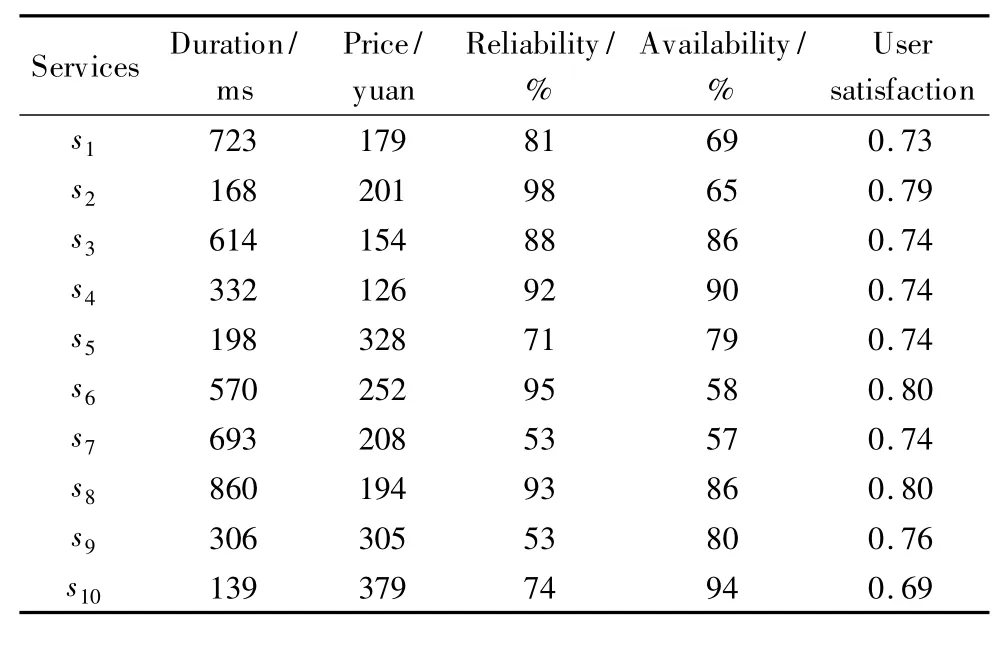
Tab.1 Trust metric values of candidate services
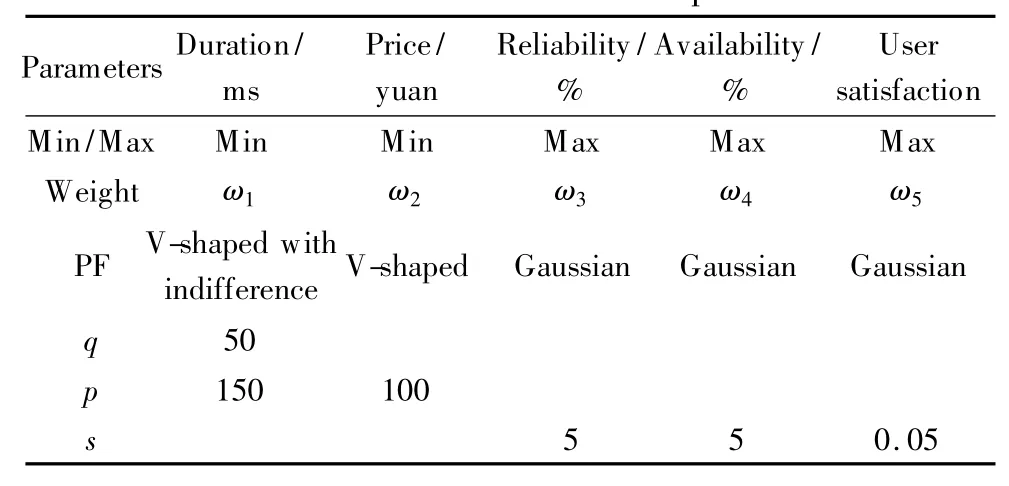
Tab.2 Preference functions and parameters

Fig.3 Changes of user satisfaction
In order to observe the changes of user satisfaction and service rank at different clock cycles,the user satisfaction values in the 1st,the 80th and the 150th clock cycle are shown in Tab.3, the other trust metric values are shown in Tab.1.The service ranking and selection process is mentioned in section 2.
First,the weight for each trust metric is determined via AHP.Assume that the user has an equivalent preference for multi-dimensional trust metrics,the AHP calculation is omitted, namely the weights vector is ω =[0.2,0.2,0.2,0.2,0.2].
Then, the weights are filled into Tab.2, and the positive,negative and net outranking flows of candidate services are calculated separately.The flow values are shown in Tab.4.The rank in the first clock iss4,s2,s3,s8,s10,s6,s5,s1,s9,s7.The rank in the 80th clock iss4,s2,s5,s4,s8,s10,s9,s6,s1,s7.The rank in the 150th clock iss4,s2,s8,s3,s10,s5,s9,s1,s6,s7.
Finally,the user can select the most trustworthy service according to the rank.With the increase in the direct interaction experience, the satisfaction value changes,followed by the changes of service rank.As a result, thedecision of the user about which service to invoke also changes.

Tab.3 Satisfaction values in different clock cycles

Tab.4 The flow values of candidate services in Case 1
Case 2Ranking candidate services according to users'preferences
In order to verify whether the proposed service selection method can effectively express a user's personalized preference,we assume that there are two users named U1and U2needing to decide which service to invoke.The preferences are expressed as follows and the trust metric values are shown in Tab.1.
First,the weight for each trust metric is determined via AHP.
1)Assume that U1sets user satisfaction as the most important metric, followed by price, duration, reliability and availability.The pairwise comparison matrix A1is constructed.λmax=5.209 7, and CR=0.047 <0.1.The weights are ω1=[0.128,0.202,0.071,0.058,0.541].

2)Assume that U2sets availability as the most important trust metric, followed by duration, reliability, user satisfaction and price.The pairwise comparison matrix A2is constructed.λmax=5.254 2, and CR=0.057 < 0.1.The weights are ω2= [0.258,0.050,0.140,0.488,0.006].
Then, the weights are filled into Tab.2, and the positive,negative and net outranking flows are calculated separately.The flow values are shown in Tab.5.The rank of services according to U1iss2,s8,s4,s6,s3,s9,s1,s5,s7,s10.The rank of services according to U2iss4,s10,s3,s5,s8,s2,s9,s6,s1,s7.

Tab.5 Flow values of candidate services in case 2
We select the top 30%services of the ranking queues,and calculate the average of their metric values.In order to show the intuitive comparison results,the average metric values of all candidate services are also calculated.The results are shown in Fig.4, and the duration and price are narrowed 10 times,while the trust is magnified 100 times.
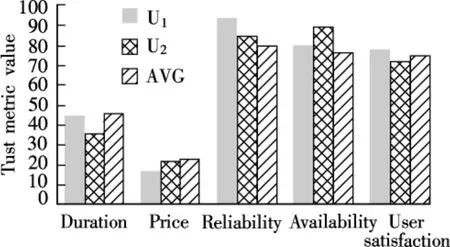
Fig.4 Trust metric values of selected services
From Fig.4, we can observe that the average values of user satisfaction,reliability and price of the selected services according to U1's preferences are better than those of the selected services according to U2's preferences.While the average values of availability and duration of the selected services according to U1's preferences are better than those of the selected services according to U2's preferences.Broadly speaking, the experimental results show that services selected by U1and U2have high user satisfaction and availability, respectively, and the other three metrics of selected services both have their pros and cons.Compared with the preferences of U1and U2,the results show that the proposed method can effectively express users'preferences for multi-dimensional trust metrics.
The two experiments show that considering the user satisfaction can improve the personalized trustworthiness of the service selection process,and the proposed service selection method combining AHP and PROMETHEE can effectively express users'preferences for trust metrics,so the personalized trustworthy service selection is realized.
Compared with the service selection methods using one-dimensional trust values,our method takes some generic QoS attributes and user satisfaction into consideration,and allows extension to other domain-specific trust metrics.The personalized trust is expressed vividly.Compared with QoS-based service selection methods,our method uses the pairwise comparison on alternative services.The weight assigned to each metric is more accurate and flexible.On the other hand, the workload of users for assigned weights is greatly reduced.Because of using PROMETHEE,the normalization operations done before calculating the trust values are not necessary, and, thus,the deviation and extra computation time caused by data processing are eliminated.We believe that these features can efficiently improve the trustworthiness of service ranking and selection.
4 Conclusion
Service selection is a critical work,which involves both functional and non-functional matching.The functional matching is the prerequisite for non-functionalbased optimal selection.Trust as a non-functional attribute plays an important role in the service selection process due to the open and dynamic environment of web services.In this paper, a personalized trustworthy service selection method is proposed.In the method, personalized trust metrics are defined and a method combining AHP and PROMETHEE is used to rank services according to users'preferences.Experimental results show that the proposed method can effectively express the preferences of users and the personalized trustworthiness is realized via defining the trust metrics.
There are a few directions we would like to work on in the future,such as designing and improving the preference function,using experimental results to guide parameters setting,and using the proposed method in the service composition process.
[1]D'Mello D A,Ananthanarayan V S.A review of dynamic Web service description and discovery techniques[C]//Proceedings of the1st International Conference on Integrated Intelligent Computing.Bangalore, India, 2010:246-251.
[2]Yu H Q, Reiff-Marganiec S.Non-functional property based service selection:a survey and classification of approaches[C]//Proceedings of the Non Functional Properties and Service Level Agreements in Service Oriented Computing Workshop Co-located with the6th IEEE European Conference on Web Services.Dublin, Ireland, 2008.
[3]Josang A,Ismail R,Bovd C.A survey of trust and reputation systems for online service provision[J].International Journal of Decision Support Systems, 2007, 43(2):618-644.
[4]Yang R T, Chen Q, Qi L Y, et al.A QoS evaluation method for personalized service requests[J].Web Infor-mation Systems and Mining, 2011, 6988:393-402.
[5]Pan J, Xu F, Xin X L, et al.A personalized trust-based approach for service selection in internetwares[C]//Proceedings of the International Conference on Advanced Computer Theory and Engineering.Phuket, Thailand,2008:89-93.
[6]Fu Ning, Zhou Xingshe, Zhan Tao.A constraint semiring based method for service's trustworthiness evaluation[J].Acta Electronica Sinica, 2011, 39(4):928-933.(in Chinese)
[7]Xu Z Q, Martin P, Powley W, et al.Reputation-enhanced QoS-based Web services discovery[C]//Proceedings of the IEEE International Conference on Web Services2007.Salt Lake City,UT,USA,2007:249-256.
[8]Zeng L, Benatallah B.QoS-aware middleware for Web services composition[J].IEEE Transactions on Software Engineering, 2004, 30(5):311-327.
[9]Lo N W,Wang C H.Web services QoS evaluation and service selection framework—a proxy-oriented approach[C]//Proceedings of IEEE Region10Conference TENCON.Taipei, China, 2007:1-5.
[10]D'Mello D A, Ananthanarayan V S.A QoS model and selection mechanism for QoS-aware Web services[C]//Proceedings of the International Conference on Data Management.Pisa, Italia, 2008:611-621.
[11]Aljazzaf Z M.Trust-based service selection[D].London,Ontario, Canada:University of Western Onrario, 2011.
[12]O'Sullivan J, Edmond D, Hofstede A H M.Formal description of non-functionalservice properties [R].Queensland,Australia:Queensland University of Technology, 2005.
[13]Saaty T L.Decision making—the analytic hierarchy and network processed(AHP/ANP)[J].Journal of Systems Science and Systems Engineering, 2004, 13(1):1-35.
[14]Brans J P, Mareschal B.PROMETHEE methods[J].Multiple Criteria Decision Analysis:State of the Art Survey, 2005, 78(3):163-186.
[15]Wilensky U.NETLOGO[EB/OL].(2011-11-10)[2012-08-01].http://ccl.northwestern.edu/netlogo/.
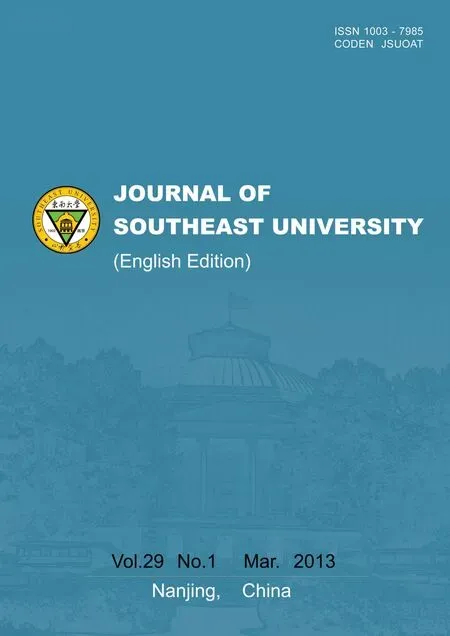 Journal of Southeast University(English Edition)2013年1期
Journal of Southeast University(English Edition)2013年1期
- Journal of Southeast University(English Edition)的其它文章
- Feature combination via importance-inhibition analysis
- Transmission cable fault detector based on waveform reconstruction
- Optimization of RDF link traversal based query execution
- W-band sharp-rejection bandpass filter with notch cavities
- Factors affecting headway regularity on bus routes
- L1-norm minimization for quaternion signals
